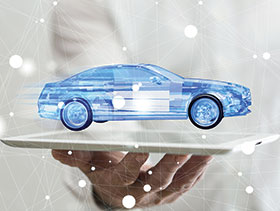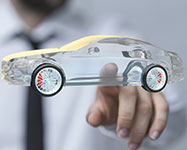

The disciplines of sensor technology, data preparation and data processing, data output, actuator engineering, connectivity and IT security come together in the Internet of Things (IoT), to which the concept of connected cars is closely linked.
Originally limited to the networking of onboard systems in vehicles, the concept is now used to describe the digitisation of the wide range of information generated in the vehicle through the networking of in-vehicle systems and the way in which the vehicle communicates with its surroundings, right through to the monetisation of data. This advanced approach enables new possibilities for mobility concepts and alignment of value chains.
For over 15 years, EBV Electrolink has been strongly focused on the automobile industry. The company supports its customers through a variety of means including energy-saving microcontrollers, sensors, connectivity solutions and embedded processors, all of which are products that form the basis for the IoT. Connected cars and IoT are therefore not uncharted territory for EBV, but areas in which the company has made its mark with strong know-how and technology solutions.
The road to autonomous driving
Digitisation is progressing rapidly, and with it, the IoT. To date, independent products are increasingly connected to the Internet – cars, commercial vehicles, motorcycles and other vehicles. The mobile operator Vodafone, for example, reported that in early 2016 there were already approximately 34 million networked machines that autonomously communicated on their mobile network, enabling applications such as connected driving, Industry 4.0 or eHealth.
Car manufacturers are working intensively on this to make vehicles into active participants on the Internet. According to car manufacturers, every second car will be a connected car by 2020. The networking of passengers and vehicles to the Internet, other vehicles and the surroundings, enables new applications and is a prerequisite for new mobility concepts. As a long-term goal, many suppliers are looking towards comfortable, autonomous driving.
Through the interplay of in-vehicle systems and networking with surroundings, connected car solutions can contribute to making both vehicles and driving safer. In addition to driving conditions, assistance systems can increasingly identify and evaluate traffic conditions. One example of this is their ability to initiate braking or lane change manoeuvres in sufficient time. Intelligent lighting systems optimally illuminate the road without dazzling oncoming traffic.
This is how Car2X communication can make a key contribution to increased transport safety in ever more heavy traffic. Should an accident nevertheless happen, then the European emergency call system, eCall, can notify the emergency services of the exact location, open up a permanent communication channel, and ensure that help is quickly on its way.
By actively networking connected cars with manufacturers and workshops, new control and maintenance services are made possible. Thanks to early diagnosis, costly repairs could well be avoided. Another possible application is update over the air, which is a simple way of updating system software. Furthermore, the extensive network of connected cars can help drivers avoid traffic jams and lead them directly to empty car parking spaces, thus reducing consumption and emissions.

Solutions for EBV customers
Internet connectivity, and the problems related to it regarding information and IT security, are areas in which many automobile companies and specialised automobile suppliers have relatively little experience. In order to sustainably occupy a leading position when it comes to the competition, they should not allow connected car developments to pass them by, but should actively pursue them instead. At the same time, companies must introduce new applications with a defined time-to-market. This, however, assumes that the developers can focus on their core competencies.
The developing companies lack resources that have the necessary special knowledge. For example, in the field of radio technology and embedded security, the use of flexible, customisable standard components, as well as cooperation with specialised partners, is recommended.
This is where EBV Electrolink comes into its own: with its extensive network of partners, the company builds bridges and helps its customers
find appropriate resources and specific expertise, in order to bring new products to market quickly. Within the context of connected cars, EBV presents itself as a solution provider for major automobile companies and small and medium-sized companies (startups, SMEs) alike, the latter often being drivers of innovation.
A challenging market environment
In the automotive industry, operating companies frequently distribute their products on a global scale. This means that they need to take note of global mega-trends in addition to local standards and developments in their target markets.
When it comes to connected car applications, this translates into a need to ensure that the networked vehicles will operate in the various different infrastructures to be found worldwide. This poses a real challenge.
The world is changing rapidly along with the weighting of the markets. In addition to the BRIC countries (Brazil, Russia, India, China and South
Africa), an increasing number of emerging, newly industrialised countries are coming into focus as promising markets for automobile producers, such as Mexico, Indonesia, Nigeria, South Korea and Turkey (MINT/MIST countries), and more recently, Vietnam, Bangladesh and many other African states.
These countries often skip whole stages of infrastructure evolution and immediately adopt the latest available technologies such as 4G/LTE or its future successor, 5G. To take Nigeria as an example, infrastructures such as wired networks are virtually non-existent in this mobile phone growth market. This has had an impact on the systems that are used in vehicles.
In addition, new players such as Internet and technology giants Google and Apple, as well as e-mobility pioneers such as Tesla, have entered the market. Automobile companies can respond to this by increasingly diversifying their offerings. They can make this happen by developing remote diagnostic technologies for predictive maintenance services or investing in leased car and share car models. The IoT is the basis for all these connected car approaches.
EBV helps its customers to gain an overview of connected cars and related opportunities, provides technical support surrounding the IoT, and organises technical seminars on applications and/or vertical markets. This is why the company always considers technologies within the context of the market, by putting itself in the position of its customers and identifying solutions on the system level. EBV implements these solutions together with suppliers and third-party providers.
Paradigm shift for information security
Connected cars represent a paradigm shift for companies in the automobile industry: previously, autonomous systems were connected to the Internet and data that was hitherto inaccessible was transmitted and processed in cloud applications. This makes them potentially vulnerable and greatly increases demands on information and IT security.
What is clear is that the corporate sector will not abandon traditional, standardised systems that have been perfected over many years without it being absolutely necessary. The transfer of today’s bus and onboard vehicular systems into a secure, web-enabled communication platform is, therefore, a focal point in connected car projects.
New approaches are sought, for example, looking at the hierarchy of control units. It is now necessary for new systems to intelligently integrate autonomous components. This could be by means of a central gateway with integrated firewall, which shields the internal, particularly security-related components of the vehicle network over the Internet. In the fields of car security, embedded security and identification, EBV Electrolink works with experienced specialists and can offer a broad solution portfolio.
The central components of a connected car strategy are the networking of systems in the car, a connection to a mobile infrastructure in the vehicle, the ability to connect to the Internet, and the way in which vehicular systems connect with their surroundings. EBV has many years of experience in each of these areas and can assist its customers by providing in-depth expertise, strong partners and the right products.
Many cars today are equipped with fieldbus systems such as MOST, LIN, CAN and FlexRay. They network the systems in the vehicle and ensure fault-tolerant, time-triggered communication between electronic components, often between sensors, actuators and control computers. In this way, they often meet tough, real-time requirements. They must also directly and securely implement steering or braking commands, for example.
Sensors are an integral part of the range of topics related to connected cars. For example, radar and camera modules can supply data to intelligently analyse a situation, which the connected car then uses in its assistance systems to actively support the driver. EBV has traditionally been strong in this area.
Smartphones are used as an interface to the Internet in many connected car applications. In order to connect to a connected car’s internal system, various different methods can be used, such as Bluetooth/Low Energy (BLE), Wi-Fi, USB/USB-C, NFC, MHL or even MirrorLink. Radio technologies and wireless charging modules in particular promise a high degree of convenience when it comes to the interaction between smartphones and vehicle systems.
A connected car can communicate with its surroundings via a mobile network or WLAN. However, previous WLAN technologies were primarily designed for stationary operation and the dynamics of a moving car can pose problems. The consequence was that radio signals could not be reliably transferred in Car2X communication. The new WLAN standard IEEE 802.11p addresses these very issues.
There are also many requirements linked to mobile communications as well: the future mobile communications standard 5G will benefit from transfer speeds of up to 10 Gbps. As vehicles will be defined as the endpoint in the sequence, each vehicle will ideally utilise the full bandwidth. This requires the car to have the ability to handle particularly fast data processing, in addition to being equipped with high-quality cabling.
The external antenna plays a crucial role in this, having evolved over the years from a little metal rod to an intelligent communication centre. These smart antennas can undertake an increasing number of tasks in the car, from being an RF transmitter and receiver of technology for mobile communications and WLAN, navigation and entertainment, including digital data processing, right through to embedded security.
EBV helps businesses to develop and implement intelligent approaches, which make use of a smart antenna as an integral part of their connected car concept. With its RF vertical segment, the company can recommend the appropriate technology produced by manufacturer-independent developers, from chips via software to antenna. In combination with powerful security technologies, customers can already lay the foundation for a comprehensive IT security concept in terms of RF technology.
For more information contact EBV Electrolink, +27 (0)21 402 1940, [email protected], www.ebv.com
| Tel: | +27 11 236 1900 |
| Email: | [email protected] |
| www: | www.ebv.com |
| Articles: | More information and articles about EBV Electrolink |

© Technews Publishing (Pty) Ltd | All Rights Reserved